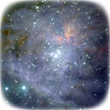
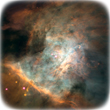
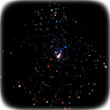
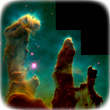
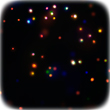
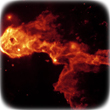
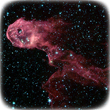
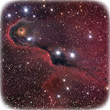
























Zoom from the constellation through the nebula to a single infant star
Credits: Image 1: Constellation Orion, Courtesy of and © Stéphane Guisard & Robert Gendler. Images 2 & 3: Orion Nebula, © Anglo-Australian Observatory/David Malin Images. Image 4: Orion Nebula © Tohoku Univ. and Subaru Telescope, National Astronomical Observatory of Japan. Image 5: Kleinmann-Low Nebula, Keck Observatory. © Lincoln Greenhill et al, 2004. Image 6: VLBA image of Source I, Lincoln Greenhill et al.
The Kleinemann-Low nebula is a cloud of dust and gas to the north of the Orion Trapezium stars. It is one of the most actively studied regions in our galaxy—in part because it is the closest region currently forming high mass stars. For our investigation, we chose a very promising infant star candidate. It is in the KL Nebula and is called by astronomers (rather prosaically) "Source I (the letter i)." Source I is buried too deeply within the cloud from which it formed to be seen with today’s optical or infrared telescopes. However, radio waves do escape the nebula, and images made with the VLBA show us enormous detail.